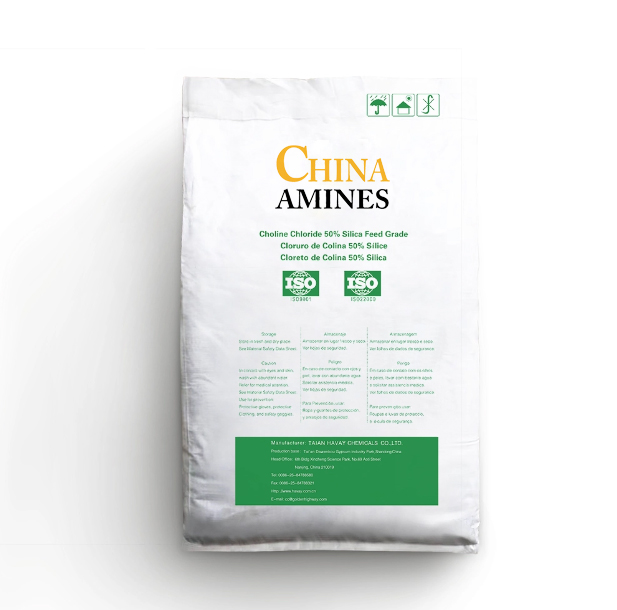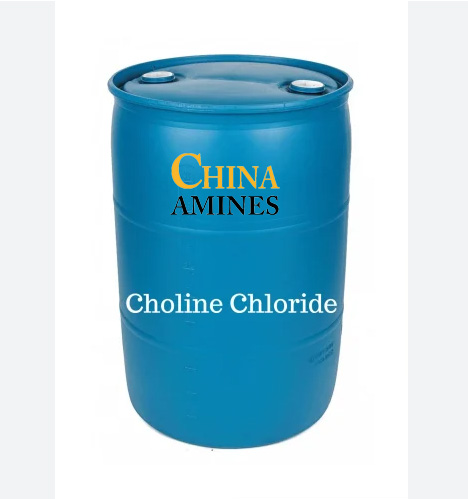1. Chemical Structure and Properties
Active Component: Choline Chloride (C₅H₁₄ClNO)
Structural Formula: [HOCH₂CH₂N⁺(CH₃)₃]Cl⁻ – a quaternary ammonium salt featuring a hydroxyl group and three methyl groups bonded to nitrogen
Carrier Material: Food-grade amorphous silica (SiO₂)
Composition: 50% choline chloride adsorbed onto 50% porous silica
Physical Properties:
Appearance: Off-white to pale yellow granular solid
Particle Size: 0.5–2 mm; Bulk Density: ~0.5–0.6 g/cm³
Moisture Content: <4% (w/w); silica minimizes hygroscopicity
Solubility: Choline chloride is water-soluble; silica remains inert but promotes dispersion
Key Features:
- Excellent flowability for automated dosing systems
- Silica desiccant action prevents caking and degradation in humid environments
2. Industrial Applications
Animal Feed:
- Function: Prevents fatty liver syndrome; supports growth and FCR optimization in poultry and swine
- Dosage: 800–1,500 g/ton (per NRC guidelines)
- Compatibility: Suitable for premix and pelleted formulations
Pharmaceutical Use:
- Excipient in extended-release formulations for choline delivery
Agriculture:
- Foliar Spray: 0.2–0.4% aqueous solution improves drought tolerance and metabolic efficiency in soybeans, tomatoes, etc.
Advantages Over Liquid/Powder Forms:
- Reduced dust and superior moisture resistance compared to starch/cellulose carriers
3. Safety and Toxicology
Choline Chloride:
- Oral Toxicity: Very low (LD50 >5,000 mg/kg, rats); non-hazardous
- Skin/Eye Contact: Mild irritation; LD50 >2,000 mg/kg (dermal)
Silica Carrier:
- Food-grade amorphous silica is GRAS (FDA 21 CFR 582.99)
- OSHA PEL: 15 mg/m³ for inert dusts; temporary respiratory irritation possible if airborne
Handling Precautions:
- Recommended PPE: N95 dust mask, gloves, goggles for bulk handling
- Storage: Keep in dry, ventilated areas to preserve flowability and shelf life
4. Environmental and Regulatory Compliance
Environmental Impact:
- Inert and non-toxic mineral-based carrier
- LC50 (fish, 96h): >100 mg/L; choline degrades to betaine (OECD 301F)
- Persistent in environment, but non-hazardous to aquatic/soil ecosystems
Regulatory Compliance:
- China: GB/T 23735–2021 certified
- USA: FDA GRAS (21 CFR 582.5250); AAFCO-listed
- EU: Approved under EC 1831/2003 (E 3.1.1) for poultry/swine
- REACH: Silica (CAS 112945-52-5) registered as non-hazardous substance
5. Case Studies and Application Insights
Case 1: Poultry Feed in Indonesia (2023)
- Conditions: 80% relative humidity
- Application: 1,200 g/ton of 50% silica choline chloride
- Outcome: 15% reduction in liver fat; 5% FCR improvement
- Benefit: $1.00/ton cost savings over liquid form due to spoilage resistance
Case 2: Tomato Cultivation in Spain (2022)
- Application: 0.3% foliar spray
- Result: 12% yield increase under drought conditions
- Mechanism: Promotes cellular water retention via betaine formation
Comparative Analysis:
- Pros: Outstanding moisture resistance, long shelf life, minimal dust
- Cons: Not biodegradable; less environmentally aligned than organic carriers like corn cob



